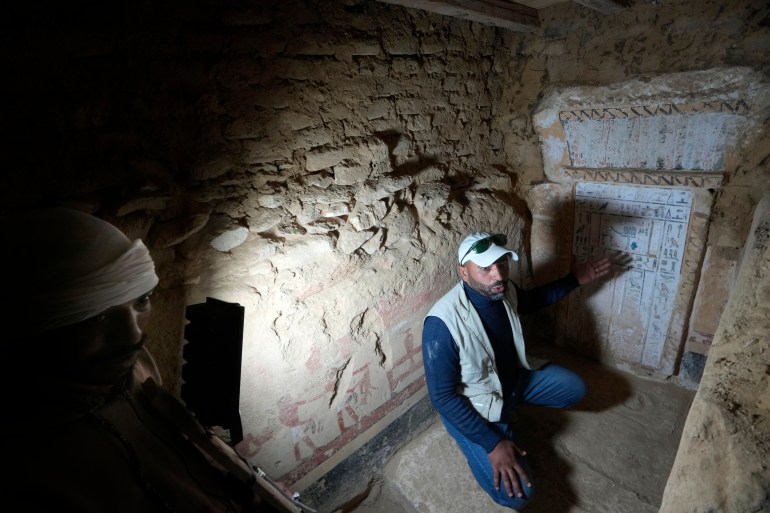The 4,300-year-old mummy was found covered in layers of gold near the Step Pyramid at Saqqara.
Egyptian archaeologists have uncovered a Pharaonic tomb near the capital, Cairo, containing what may be the oldest and “most complete” mummy yet to be discovered in the country.
The 4,300-year-old mummy was found at the bottom of a 15-metre (49-foot) shaft in a recently uncovered group of tombs dating back to the fifth and sixth dynasties of the Old Kingdom near the Step Pyramid at Saqqara, Zahi Hawass, director of the team, told reporters on Thursday.
The mummy, of a man named Hekashepes, featured a “gold-leaf covering” and was in a limestone sarcophagus that had been sealed in mortar.
“I put my head inside to see what was inside the sarcophagus: a beautiful mummy of a man completely covered in layers of gold,” Hawass said. “This mummy may be the oldest and most complete mummy found in Egypt to date.”
Among other tombs found was one belonging to Khnumdjedef, an inspector of officials, supervisor of nobles and priest during the reign of Unas, the last pharaoh of the fifth dynasty. It was decorated with scenes of daily life.

Another tomb belonged to Meri – “keeper of the secrets and assistant to the great leader of the palace”.
The priestly title of “secret keeper” was held by a senior palace official bestowing the power and authority to perform special religious rituals.
A third tomb belonged to a priest in Pharaoh Pepi I’s pyramid complex, and the fourth to a judge and writer named Fetek, Hawass added.
Fetek’s tomb included a collection of “the largest statues” ever found in the area, Mostafa Waziri, head of Egypt’s Supreme Council of Antiquities, said.
Numerous statues were found among the tombs, including one representing a man and his wife and several servants.
The vast burial site at the ancient Egyptian capital, Memphis, a UNESCO World Heritage Site, is home to more than a dozen pyramids, animal graves and old Coptic Christian monasteries.
In a separate announcement earlier in the week, a group of scientists from Cairo University revealed previously unknown details about a mummified teenage boy dating to about 300 BC.
By using CT scans, the team of scientists shed new light on the boy’s high social status by affirming the intricate details of the amulets inserted within his mummified body and the type of burial he received.
Source
:
Al Jazeera and news agencies









